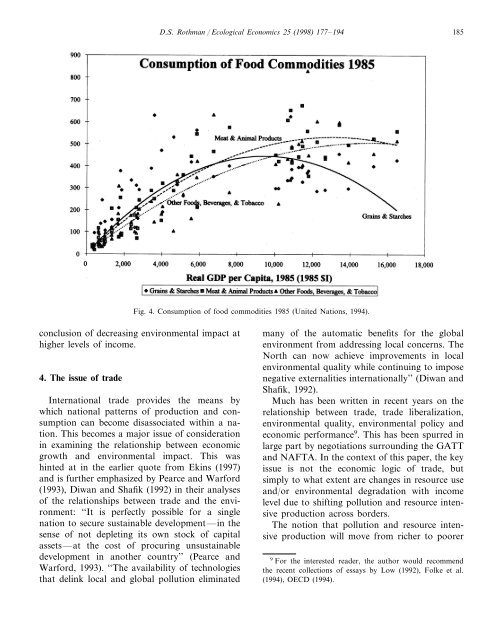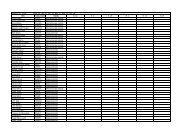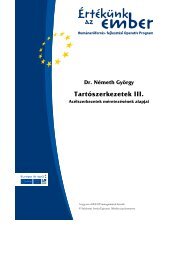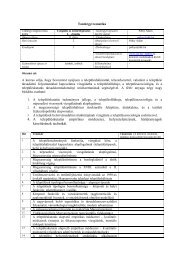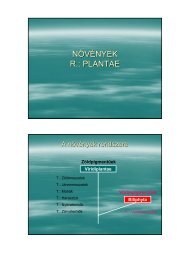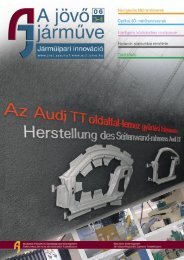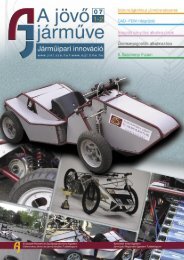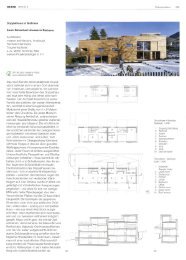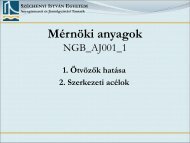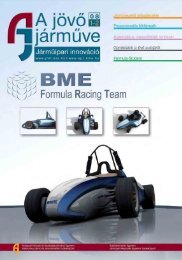Environmental Kuznets curves—real progress or passing the buck ...
Environmental Kuznets curves—real progress or passing the buck ...
Environmental Kuznets curves—real progress or passing the buck ...
You also want an ePaper? Increase the reach of your titles
YUMPU automatically turns print PDFs into web optimized ePapers that Google loves.
D.S. Rothman / Ecological Economics 25 (1998) 177–194 185<br />
Fig. 4. Consumption of food commodities 1985 (United Nations, 1994).<br />
conclusion of decreasing environmental impact at<br />
higher levels of income.<br />
4. The issue of trade<br />
International trade provides <strong>the</strong> means by<br />
which national patterns of production and consumption<br />
can become disassociated within a nation.<br />
This becomes a maj<strong>or</strong> issue of consideration<br />
in examining <strong>the</strong> relationship between economic<br />
growth and environmental impact. This was<br />
hinted at in <strong>the</strong> earlier quote from Ekins (1997)<br />
and is fur<strong>the</strong>r emphasized by Pearce and Warf<strong>or</strong>d<br />
(1993), Diwan and Shafik (1992) in <strong>the</strong>ir analyses<br />
of <strong>the</strong> relationships between trade and <strong>the</strong> environment:<br />
‘‘It is perfectly possible f<strong>or</strong> a single<br />
nation to secure sustainable development—in <strong>the</strong><br />
sense of not depleting its own stock of capital<br />
assets—at <strong>the</strong> cost of procuring unsustainable<br />
development in ano<strong>the</strong>r country’’ (Pearce and<br />
Warf<strong>or</strong>d, 1993). ‘‘The availability of technologies<br />
that delink local and global pollution eliminated<br />
many of <strong>the</strong> automatic benefits f<strong>or</strong> <strong>the</strong> global<br />
environment from addressing local concerns. The<br />
N<strong>or</strong>th can now achieve improvements in local<br />
environmental quality while continuing to impose<br />
negative externalities internationally’’ (Diwan and<br />
Shafik, 1992).<br />
Much has been written in recent years on <strong>the</strong><br />
relationship between trade, trade liberalization,<br />
environmental quality, environmental policy and<br />
economic perf<strong>or</strong>mance 9 . This has been spurred in<br />
large part by negotiations surrounding <strong>the</strong> GATT<br />
and NAFTA. In <strong>the</strong> context of this paper, <strong>the</strong> key<br />
issue is not <strong>the</strong> economic logic of trade, but<br />
simply to what extent are changes in resource use<br />
and/<strong>or</strong> environmental degradation with income<br />
level due to shifting pollution and resource intensive<br />
production across b<strong>or</strong>ders.<br />
The notion that pollution and resource intensive<br />
production will move from richer to po<strong>or</strong>er<br />
9 F<strong>or</strong> <strong>the</strong> interested reader, <strong>the</strong> auth<strong>or</strong> would recommend<br />
<strong>the</strong> recent collections of essays by Low (1992), Folke et al.<br />
(1994), OECD (1994).


